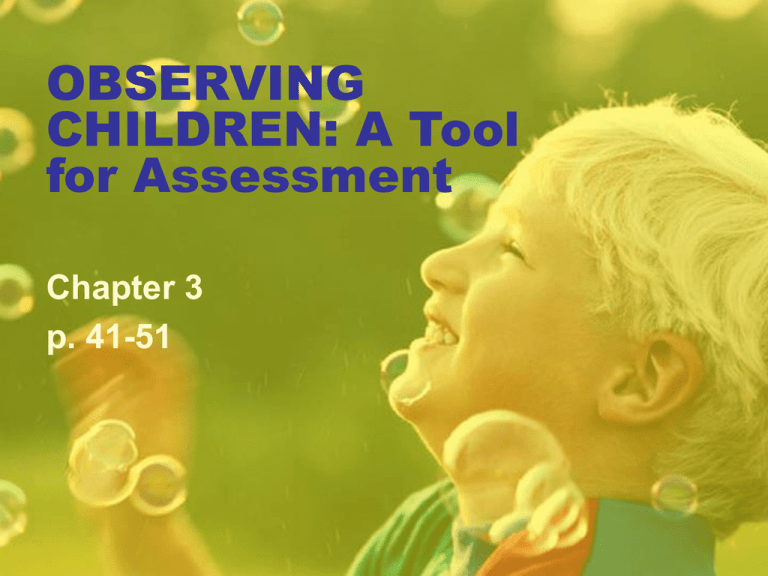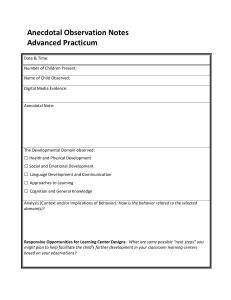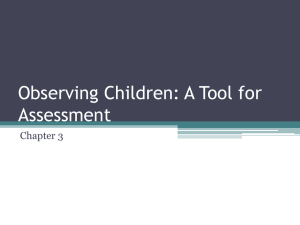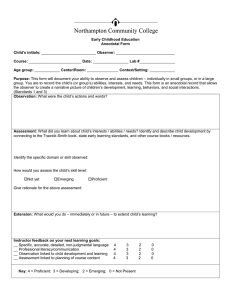OBSERVING CHILDREN: A Tool for Assessment
advertisement

OBSERVING CHILDREN: A Tool for Assessment Chapter 3 p. 41-51 TERMS TO KNOW: Define • • • • • • • Anecdotal record Assessment Developmental norms Checklist Participation chart Rating scale Portfolio Observing Children • Video: 11 min • True or False Hunt – Correct false statements to make true ASSESSMENT • The process of observing, recording, and documenting children’s growth and behavior. • Information is obtained on children’s developmental status, growth, and learning styles • Assessment vs. Evaluation AUTHENTIC ASSESSMENT… • Focus on physical, cognitive, social, and emotional development • Involve children working with everyday objects and materials • Include a variety of data collected across time • Help teachers identify each child’s developmental needs and learning styles • Evaluate each child’s progress and performance over time • Be collected by persons familiar with the child • Be used to determine progress of the class as a whole • Identify those children who have special needs … • Include a variety of methods • Identify the children’s strengths, needs, and other interests • Involve parents, families, teachers, children, and other professionals • Give parents and families understandable information that describes their child’s progress • Identify and help solve and classroom problems • Be used to evaluate teaching effectiveness • Be used in planning developmentally appropriate curriculum • Be used in evaluating the program’s effectiveness in meeting its goals and objectives ASSESSMENT TOOLS: Chart Comparison: Advantages, Disadvantages, and Uses • • • • • • • • *Anecdotal Records *Checklists *Participation Charts *Rating Scales Sample of Products Photographs Video Interviews EVALUATION: REVIEWING ASSESSMENT DATA • Questions to ask when reviewing the data… – – – – – – What evidence of progress is shown? What are the child’s needs, interests, and abilities? Are there concerns about the child’s development? Are there concerns about the child’s health? Are there any behavior problems? Does the child show positive self-esteem? • Summary statements to be formulated: – – – – – – Evidence of progress Needs, interests, and abilities Development Health Behavior Self-esteem GUIDELINES FOR OBSERVING CHILDREN • Information collected about children and families must be kept confidential • Arrive on time and in appropriate dress • Do not discuss a child’s behavior outside the classroom • Use first names only in discussions • Do not bring personal belongings into the classroom when you observe • Avoid talking to other observers or the staff when you observe • Respect the children and never enter into play unless invited • Sit away from the action so you don’t interfere or cause a disruption by your presence • If a child asks you what you are doing, answer in a matterof-fact manner • Avoid judging the teacher or the program WRITING ANECDOTAL RECORDS • Used to develop an understanding of a child’s behavior – Observe children playing, learning, and interacting • Must be objective (observable actions and nonevaluative) – – – – Who was involved What happened When it happened Where it occurred • Example: pg 46 • Descriptive or Interpretive practice worksheet • Anecdotal Record Assignment: Due Monday, January 14th Chapter 3 Test • TBD











